The Issue of Narrative Clarity—Audience Familiarity
The Edison Manufacturing Company's continued reliance on pre-nickelodeon production practices was not confined to filmmaking as such, but included the ways that viewers were expected to understand the resulting subjects. Methods of reception or appreciation remained much as they had been since the late 1890s. Representational practices fell into three basic categories, with the basis for comprehension centered either in the spectator, the exhibitor, or the film itself. None of these dominated or was necessarily preferred. In fact, they were complementary and often interdependent. All involved redundancy in different forms.
Porter and his contemporaries continued to rely on audience awareness of hits, crazes, and well-known stories within popular culture. This meant a different relationship between audience and cultural object than in more elevated culture, where narratives were usually presented with the assumption that audiences were encountering them for the first time. The Night Before Christmas (December 1905) "closely follows the time honored Christmas legend by Clement Clarke Moore, and is sure to appeal to everyone-both old and young."[50] Lines from the poem were used to introduce several scenes, helping the audience to maintain a conscious correspondence between the screen drama and the book, continuing a representational practice evident in Uncle Tom's Cabin . Relying on the audience's previous knowledge of Moore's poem, Porter established the necessary narrative clarity even while instilling a degree of nostalgia for lost childhoods. The film's success depended primarily on the spectacle and
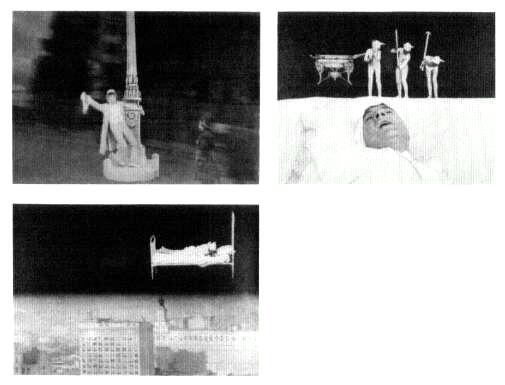
Dream of a Rarebit Fiend, scenes 2, 4, and 6.
novelty of Porter's execution—on the way he told a familiar story, not on the novelty of the story itself.
The next Edison film, Dream of a Rarebit Fiend , was partially inspired by Winsor McCay's comic strip "Dream of the Rarebit Fiend," which had appeared in the New York Telegram since 1904.[51] Porter not only borrowed the title but shared McCay's dream-based narrative structure, elements that had already figured in Biograph's somewhat earlier Dream of the Race-Track Fiend (September 1905). Likewise, the Edison film convincingly realized McCay's surreal imagery on the screen using a variety of photographic tricks—an achievement not attempted in the earlier Biograph film. Although such visuals had many antecedents, Porter may have found another McCay strip, "Little Nemo in Slumberland," a useful point of departure. The basic story line and some of the film's visuals, however, can be found in an earlier Pathé film made by Gaston Velle—Rêve à la lune (1905):
A brave drunkard is surrounded by gigantic bottles in human form, with which he executes a wild, disorderly quadrille. Next he sleeps. . . . He fancies himself in a public square under the kindly gaze of the moon, with which he immediately falls in love.
He wishes to reach it and, to do this, grabs onto a lamp post. But the moon is still too far away. Our man does not hesitate but jumps the wall of a nearby house. . . . Not without several pitfalls, he reaches the roof of the house, on which he has difficulty maintaining his balance, for there are several close calls when he could have been hurled down into the void. He falls while crossing an attic window and disturbs the neighbors.
But our obstinate drunkard still wants to catch the moon. He leans against a chimney-flue, which wobbles on its base. Suddenly a hurricane appears and carries our man into space, always riding the flue. He covers many miles, crossing the clouds while the storm rages around him. He is in outer space, about to catch the object of his desire. The moon itself awaits his efforts, approaches him and extends its hospitality to him. He resolutely enters the brilliant star and penetrates its mouth. But the moon does not seem to take warmly to the visitor, for after several expressions of distaste, it spits the poor drunkard into space, and we see him rapidly tumble toward earth to end up finally in his bed, where he immediately awakens from his strange dream.[52]
Porter's use of the McCay title not only provided a frame of reference that helped audiences understand the dream transitions but obscured his borrowings from the Velle narrative. Familiarity with the McCay comic strip was not as necessary to audience understanding of the narrative as it was for many other films. In this respect, Dream of a Rarebit Fiend conforms to more modern expectations of adaptation.[53]
The film begins with a medium shot of the fiend consuming large amounts of alcohol and Welsh rarebit. For subsequent scenes, Porter employed a different special effect for each shot, keeping the spectator off balance and making it impossible for the average viewer to figure out how the photographic stunts were achieved. The second shot was a double-exposure, superimposing the fiend and a swinging white lamppost against rapidly panning, zigzagging camerawork of New York City streets. It suggested the subjective sensation of the fiend's predicament without being a point-of-view shot. When the man enters his bedroom (scene 3) invisible strings drag his shoes across the floor and stop action causes the furniture to disappear. The fourth scene uses a split-screen effect—juxtaposing a close-up of the sleeping fiend with a far shot of people in devils' costumes, making it appear that they are hitting him on the head with forks and shovels. When Porter cuts back to the room, it is a miniature that allows the filmmaker to manipulate the bed in astonishing ways. The sixth scene uses another type of split screen as the fiend's bed travels across the skyline of New York. Scene 7 uses a drawn background and cut-outs. Scene 8 is a studio close-up of a steeple on which the fiend is skewered. The final scene returns to the bedroom as the dreamer crashes through the roof and wakes up. The changing tricks and discontinuities disorient the spectators in ways analogous to dream, particularly the dreams portrayed in Winsor McCay's comic strips.
The Terrible Kids (April 1906) was part of the widespread comic depiction of undersocialized youth. In the cinema, the popular bad boy genre would soon
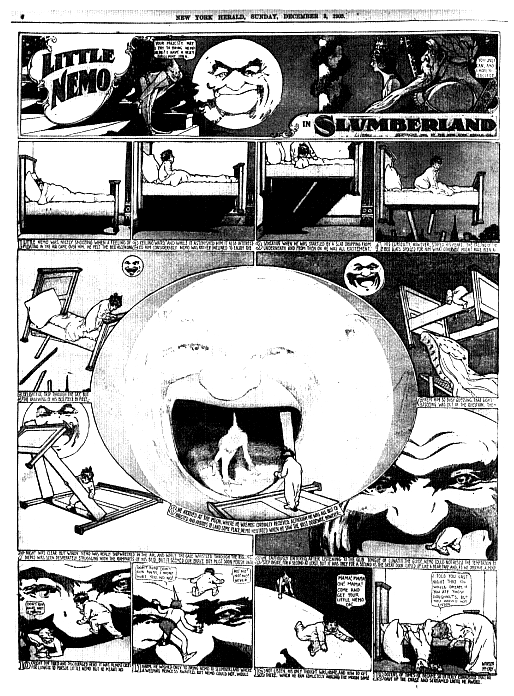
This Winsor McCay cartoon strip shares many similarities with Dream of a Rarebit Fiend.
Little Nemo's dream, however, is caused by too many donuts.
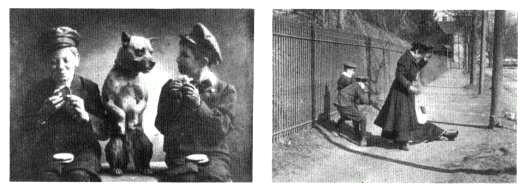
The "terrible kids" and their faithful dog wreak havoc on the adult world.
come under heavy criticism for providing young viewers with undesirable role models. Porter's comedy shows two boys disrupting a neighborhood's routine with the help of their dog, played by Mannie. Every scene is a variation on a mischievous prank: Mannie "jumps onto the Chinaman's back, seizes his queue and drags the poor chink to the ground"; when they encounter a billposter on a ladder, the dog "grabs the billposter by the leg of his trousers and he falls to the ground with the ladder on top of him while the kids enjoy the billposter's predicament."[54] Several women and an Italian apple vendor with a push cart are also victims. Eventually these annoyed adults turn pursuers and capture the two pranksters with the help of the police. As the boys are driven off in the police van, Mannie opens the van door, and the kids escape as the film ends.
Delinquent kids appear constantly in early film comedies. James Williamson's The Dear Boys Home for the Holidays (1903) and Our New Errand Boy (1905), Biograph's The Truants (1907) and Terrible Ted (1907); Pathé's Les Petits Vagabonds (1905), and Porter's own The Little Train Robbery (1905) are just a few additional examples of the bad boy genre. Others such as Biograph's Foxy Grandpa Series (1902) and Edison's Buster Brown Series (1904) had comic strip antecedents and also became plays. The Amusement Supply Company offered a full program of five films and fifty-two "life model" stereopticon slides on Peck's Bad Boy and His Pa , which were meant to illustrate the best-selling book of the same title.[55] In all of these films one or two boys disrupt staid adult life and undermine authority. While Foxy Grandpa outwits the boys on their own terms (showing that the child exists in all of us and that Grandpa is entering a second childhood), more often than not the adults are easily fooled.
The relationship of The Terrible Kids to similar films (and to the bad boy genre in other popular forms) was an essential part of the film's meaning. Since the boys in these films were anonymous, intertextual and intratextual redun-
dancy were essentially of the same kind. The audience's frequent encounters with similar texts provided the reassurance of familiarity. Audiences were expected to identify and sympathize with the kids, suggesting a nostalgic desire for a simpler, less regimented past. According to the catalog description of The Terrible Kids , "The antics of the kids, the almost human intelligence of 'Mannie' and the narrow escapes from capture, are a source of constant amusement and are sure to arouse a strong sympathy for the kids and their dog."[56] The genre savors the rejection of authority even as it offers a momentary release from the increasingly regimented workplace. The bad boys escape at the end of both The Terrible Kids and The Little Train Robbery —as if to appear in some other film.
While scanning the newspapers of this period, one constantly stumbles across antecedents for American films. This suggests that virtually every film functioned within a well-established intertextual context. Even a film with as simple and obvious a narrative as How the Office Boy Saw the Ball Game conformed to a popular stereotype. Released in July 1906, much of the subject was recycled from Play Ball , a topical film Porter had shot the previous year on opening day of the National League baseball season. A week after that game, the New York World published a full-page photograph of the crowd with the caption, "If your office boy or any of your clerks had sudden calls to the funerals of grandmothers or uncles on that memorable Saturday perhaps you might shed a little light on the matter by a close scrutiny of this picture."[57] This caption articulated the premise of Porter's film. In a small office, the lady stenographer writes a note for the office boy that reads "Dear Teddy: Come home at once. Grandma is dead." The boss accepts the excuse and the office boy has a free afternoon to see the game. The young lady stenographer faints in disbelief when the boss falls for the explanation. The bookkeeper is told to escort her home. Left alone, the broker also decides to take the afternoon off and see the game. The remainder of the film intercuts Teddy on a telephone pole looking through a spyglass with masked point-of-view shots of the game—including a view of the boss discovering the stenographer and bookkeeper in the stands (the matte, as was customary, was added at the printing stage). For a short time they are all kids again, playing hooky from adult responsibility. Unlike Teddy, whose skylarking remains undetected and hence unpunished, the stenographer and bookkeeper are reprimanded by authority. They play by some rules (they pay to see the game) but not others. Teddy, safe on his distant perch, does not pay to see the game (either with money or by suffering the boss's wrath). Like the "terrible kids," he can disregard societal rules and get away with it—something adult characters seldom succeed in doing.
In How the Office Boy Saw the Ball Game , Porter celebrates baseball as a unifying activity that cuts across age and class barriers. Movie patrons are encouraged to recall their childhoods nostalgically, for they see the game through
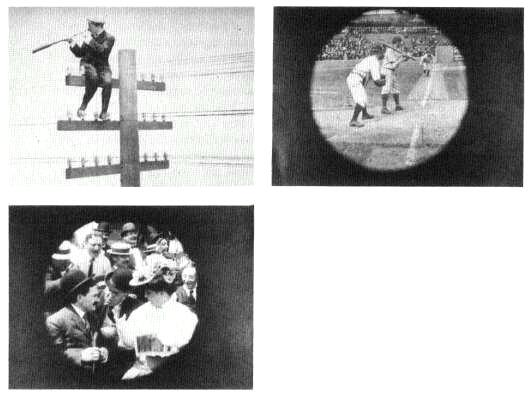
The office boy sees not only the ballgame but his boss lecturing the bookkeeper and stenographer for attending the game.
the office boy's spyglass—from his point of view. The spectator, however, regresses nostalgically to his childhood. Gender is presumed to be male—like the filmmaker and the office boy. As Adrienne Harris has pointed out, "Baseball is centrally a place without time and without women."[58] In 1906 the game reflected the male-dominated world in which and about which Porter and others made their films. Whether the stenographer is in the office or at the ballgame, her position is in the margins. She never speaks in her own voice. She writes Teddy's note—signing someone else's name, and her main job is to record the male boss's words. Even when she faints, it only becomes an excuse for the bookkeeper to escape as well. Likewise in baseball, if a woman speaks, Harris suggests, it will be as "a false mock male self."[59] In How the Office Boy Saw the Ball Game , the boy's point-of-view shots of the game reproduce the male-fetishized close-up of the woman's ankle in The Gay Shoe Clerk , but in an appropriate latency-age form. Women spectators of both The Terrible Kids and How the Office Boy Saw the Ball Game are likewise forced to assume the role of a false mock male self to enjoy the films in the spirit in which they were made.
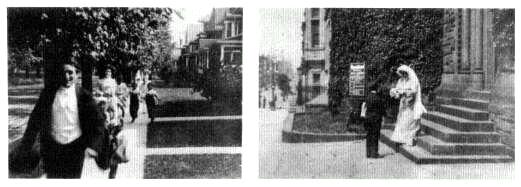
Obadiah Binks tries to elude his family, and his jilted bride is left "waiting at the church."
While The Terrible Kids conformed to a genre diffused throughout Western popular and mass culture and How the Office Boy Saw the Ball Game was based on a generalized, urban American witticism about office boys and ballgames, Waiting at the Church (July 1906) required spectators to be familiar with the lyrics of one specific song, a hit popularized by Vesta Victoria (see document no. 20). As one vaudeville manager noted, "to those who know the song, this is extremely funny."[60] The film itself was described in Views and Film Index :
WAITING AT THE CHURCH
Obadiah Binks is sitting on a bench in the park. A young lady strolls along and finally seats herself very comfortably on the same bench. Before long they engage in conversation and Obadiah proposes. At first she is surprised by the very sudden announcement of his love for her, but she suddenly falls upon his neck and hugs and kisses are mutual. He declares his love for her and they agree upon a date to get married.
Obadiah's home is then shown. Finally the young lady is seen waiting at the church for Obadiah. He does not come but sends a messenger with a note in which he states, "Can't get away to marry you today: my wife won't let me."[61]
This brief trade description passes over Porter's elaboration of the song's simple story. Porter did more than merely illustrate the song. Although the original lyrics are from the woman's point of view, the film shifts the focus to Obadiah Binks. No longer a con artist who robs a naive, sexually frustrated woman of her money, Obadiah is portrayed as a zany bigamist trying to outwit one wife so that he can marry a second. The discrepancy between the lyrics and the film narrative is an essential part of the picture's humor. The film's farcical tone is retained, but the story is explored from a new perspective.
DOCUMENT No. 20 |
WAITING AT THE; CHURCH |
Written by Fred W. Leigh Composed by Henry E. Pether Published by Francis, Day and Hunter [New York, 1906] |
1. I'm in a nice bit of trouble |
Somebody with me has had a game |
I should by now be a proud and happy bride |
But I've still got to keep my single name |
I was proposed to by Obadiah Binks |
In a very gentlemanly way |
Lent him all my money so that he could buy the home |
And punctually at twelve o'clock today |
Chorus: |
There was I waiting at the church |
Waiting at the church, |
When I found he'd left me in the lurch |
Lot, how it did upset me! |
All at once he sent me round a note |
Here's the very note |
This is what he wrote |
Can't get away to marry you today |
My wife won't let me. |
2. Lor, what a fuss Obadiah made of me |
When he used to take me to the Park |
He use to squeeze me till I was black and blue. |
When he kissed me he used to leave a mark. |
Each time he met me he treated me to wine |
Took me now and then to see the play |
Understand me rightly when I say he treated me |
It wasn't him but me that use to pay. |
Just think of how disappointed I must feel |
I'll be going crazy very soon |
I've lost my husband the one I never had |
And I dreamed so about my honeymoon! |
(Text box continued on next page)
I'm looking for another Obadiah |
I've already bought the wedding ring |
There's all my little faltheriddles packed in my box |
Yes, absolutely two of everything. |
With Waiting at the Church , Porter used redundancy in several different ways. The song's familiarity was incorporated into the psychology of the characters as well as the narrative. When Obadiah is chased by his wife and children, they seem to have gone through this routine before. Determined to keep the family together and knowing what to expect, they prevent him from reaching his would-be bride "waiting at the church." Actions and situations are also repeated through the use of similar chase scenes. Like the chorus of the song itself, redundancy is the central organizing principle of the film.
The "Teddy" Bears was not only one of Porter's personal favorites but serves as a rich, revealing example of the filmmaker's work in the early nickelodeon era.[62] Advertised as "a laughable satire on the popular craze,"[63] Porter and McCutcheon's first film of 1907 was completed in late February. The juxtaposition of two different referents is an important element of The "Teddy" Bears ' humor and success. It starts out as an adaptation of "Goldilocks and the Three Bears" and works within the framework of the fairy-tale film. For the first two-thirds of its running time, the life-sized teddy bears (actors in costume) are the subject of an endearing children's film. Suddenly the picture moves outside the confines of the studio, changing moods and referents. The bears chase Goldilocks across a snowy landscape until "Teddy" Roosevelt intervenes, kills the two full-grown pursuers, and captures the baby bear.
The sudden appearance of "Teddy" was based on a well-known incident when President Roosevelt was on a hunting expedition in Mississippi and refused to shoot a bear cub. This was in November 1902. Shortly thereafter Morris Michtom, a Russian immigrant who ran a small toy store and would eventually start the Ideal Toy Corporation, began to make and sell "Teddy's bear"—a stuffed version of the spared cub. The novelty had become a craze by 1906-7, when thousands of toy bears were being sold each week and music such as "The Teddy Bear March" (copyrighted 1907) was popular.[64] Unless audiences appreciated the shift in referents, the killing of the two endearing bears seemed bizarre and at odds with the earlier part of the film. Sime Silverman missed the point in his Variety review when he wrote:
Probably based on the fairy tale of "Goldielocks and the Three Bears," The Teddy Bears series at the Colonial this week is made enjoyable through the mechanical acrobatic antics of a group of fluffy haired little hand-made animals. The closing pictures
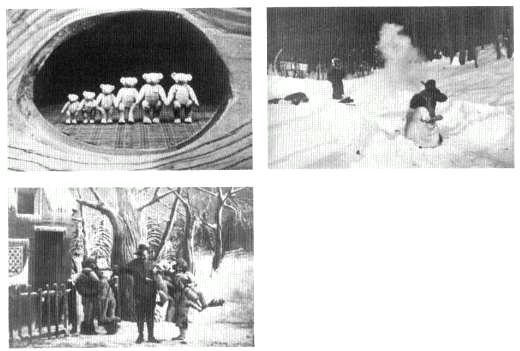
The "Teddy" Bears unexpectedly shifts moods from animated stuffed animals in the first part to the
killing of anthropomorphic bears in the second. Porter also juxtaposed location shots with exterior
scenes set in the studio.
showing the pursuit of the child by the bear family is spoiled through a hunter appearing on the scene and shooting two. Children will rebel against this position. Considerable comedy is had through a chase in the snow, but the live bears seemed so domesticated that the deliberate murder in an obviously "faked" series left a wrong taste of the picture as a whole.[65]
Not everyone agreed with Sime.[66] The shift in referents revealed to the audience that The "Teddy" Bears was not simply a children's film, but was also aimed, like Lewis Carroll's Alice in Wonderland , at adults. By judging the film from the viewpoint of a child, who could not be expected to grasp a range of contemporary references, Sime postulated a relation between viewer and cultural object that would be more applicable to later cinema. In fact, his review is one of several indications that criteria for assessing films were changing and that subjects relying on an audience's prior familiarity with narrative elements were being received with less sympathy.
The "Teddy" Bears is a political burlesque on Teddy Roosevelt, reminiscent of Terrible Teddy, the Grizzly King and The Strenuous Life; or, Anti-Race Suicide . As Sime noted, the bear family's anthropomorphic activities have endeared the animals to the audience by the time the Roosevelt hunter appears on
the scene. Audiences then tend to react unsympathetically to his shooting of the two adult bears. The liberal press sometimes expressed a similar viewpoint. After Roosevelt killed a she bear in 1907, the New York World responded with a front-page column devoted to the critical remarks of nature writer Dr. William J. Long. Headlines read: "Calls Roosevelt Bear Killing Pure Brute Cowardice."[67]
Porter's continuing commitment to pre-nickelodeon representational strategies is also evidenced in the shot construction of The "Teddy" Bears . The film has eighteen shots: the first thirteen and the last were taken in the studio, while the four chase scenes were photographed outside in a city park. Although Griffith was to shoot interiors in the studio and exteriors on location on a regular basis by 1909, Porter never developed this convention of consistent mimetic realism, at least in his Edison films. From our post-Griffith perspective, studio scenes of the bear-house exterior are at odds with those photographed in the park. Although this syncretism can feel misplaced or naive today, Porter's studio work was generally motivated by a desire for greater control over the mise-en-scène. Correspondingly, Porter's frequent reliance on the chase encouraged location shooting and prevented films from becoming claustrophobic.
Shots continued to be conceived as discrete units in The "Teddy" Bears , even though editorial control was firmly in Porter's hands. As before, each scene has its own self-enclosed temporality, which is related to outgoing and incoming shots by repeated actions and the unfolding story. Goldilocks' exit through a hallway (shot 7) is followed by an entrance into the bedroom (shot 8), another example of Porter's familiar uses of the temporal overlap. There is no matching action or linear continuity. Mismatches in screen direction and conflicting entrances and exits further reveal the discrete nature of individual scenes. The "Teddy" Bears makes rich and effective use of a representational system Porter had explored and developed since his arrival at Edison. Within this system, he continued to mature as a filmmaker.
Porter drew on the same repertoire of techniques in Cohen's Fire Sale (June 1907), which focuses on a Jewish milliner whose merchandise is inadvertently taken away by a garbage man and ends up in the city dump. The shopkeeper recoups his investment by starting a small fire in his store and covering the damage through insurance. He benefits still further by a fire sale, which quickly clears the store of imperfect goods. The story is based on the stereotypical Jewish businessman for whom fire was "our friend" and the fire company was "our enemy"—a view rendered in iconographic form on a comic postcard of the period. The story itself is quite simple and clearly depicted; but character motivation, narrative logic, and audience comprehension of a few key pieces of information—for instance that a piece of paper is an insurance policy—relies on this highly specific anti-Semitic stereotyping. Here redundancy reinforces those ethnic prejudices that audiences initially relied on to understand the film.
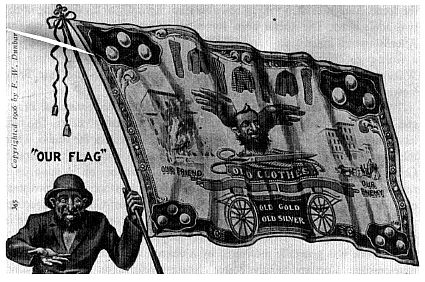
An anti-Semitic "comic" postcard of the period.
Cohen's Fire Sale integrates pasteboard representations and actual objects in extreme ways. Hats in the foreground of Cohen's display are real—those in the background are painted. Cohen's sleeping cat suddenly becomes a pasteboard animal when its tail is tied to the kerosene lamp. Though these syncretic juxtapositions differ little from Porter's set-design strategies in The Finish of Bridget McKeen (1901), the quality and detail of execution have improved. Again the exterior of Cohen's store is a set, while other scenes were filmed on New York City streets. Scenes of a fire truck coming out of the station and of the firefighting are actuality material, taken of a fire company in action. Like Porter's previous work, Cohen's Fire Sale incorporates a diversity of mimetic representations and undercuts any notion of a seamless continuity. Shots continue to act as self-contained units of representation in other ways as well. Chase scenes integrate narrative elements like the pursuing shopkeeper with superfluous incidents that had appeared in turn-of-the-century, one-shot films. In one scene, for instance, street gamins wear some of Cohen's misplaced hats and dance a cakewalk until Cohen arrives to take away the headwear.
Porter's construction of shots and his frequent reliance on audience familiarity with a film's subject were part of the same representational system. If one shot did not follow clearly after another or if extraneous elements were introduced, audiences had a frame of reference that allowed them to fill in gaps or follow the narrative's main line. If spectators lacked the necessary frame of reference, they missed the joke or could not follow the story line. Novelty of
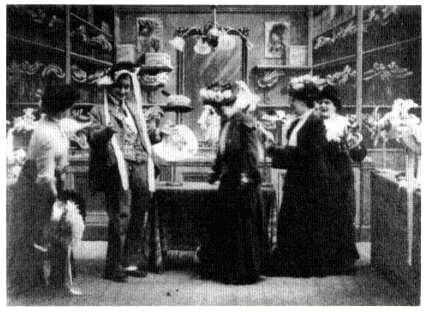
Cohen tries to sell his damaged goods.
execution and familiarity of subject matter were the basis of this approach. Although Porter's reliance on the audience's prior knowledge was extreme for the period, it nonetheless characterized and crystalized the distinctive elements of this period's representational system.